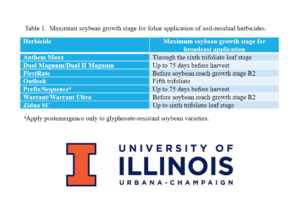Residual Soybean Herbicides Applied Postemergence
Soil-residual herbicides are important components of integrated weed management programs. Reducing the number of weeds exposed to foliar-applied herbicides helps reduce the selection intensity for weeds resistant to foliar-applied herbicides. Residual herbicides applied with postemergence soybean herbicides also can reduce the need for a second postemergence application. However, simply applying a soil-residual herbicide does not guarantee the product will provide the desired level or duration of weed control. Many edaphic and environmental factors influence the level of weed control achieved by soil-residual herbicides.
Soil-residual herbicides applied with postemergence herbicides require precipitation to move them into the soil solution where they are available for uptake. Herbicide effectiveness is reduced when a soil-residual herbicide is sprayed on a dry soil surface with no precipitation for several days following application. Residual herbicides generally require 0.5 to 1.0 inch of precipitation within 7 to10 days after application for optimal incorporation. Soil condition, soil moisture content, residue cover, and the chemical properties of the herbicide influence how much and how soon after application precipitation is needed for optimal activity.
Also, keep in mind the labels of soil-residual products include a maximum soybean growth stage or time interval prior to harvest beyond which an application cannot be made. A sample of these growth stages and preharvest intervals is presented in Table 1.






